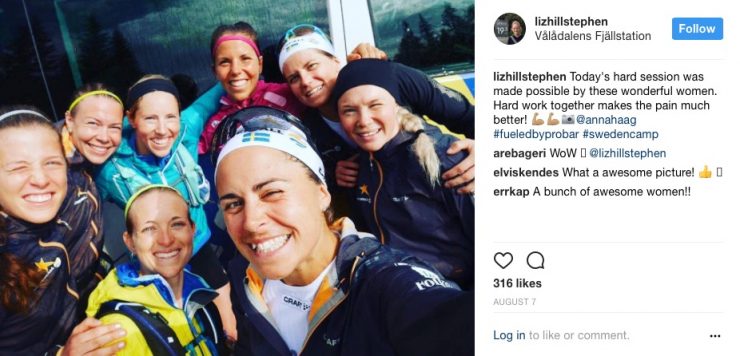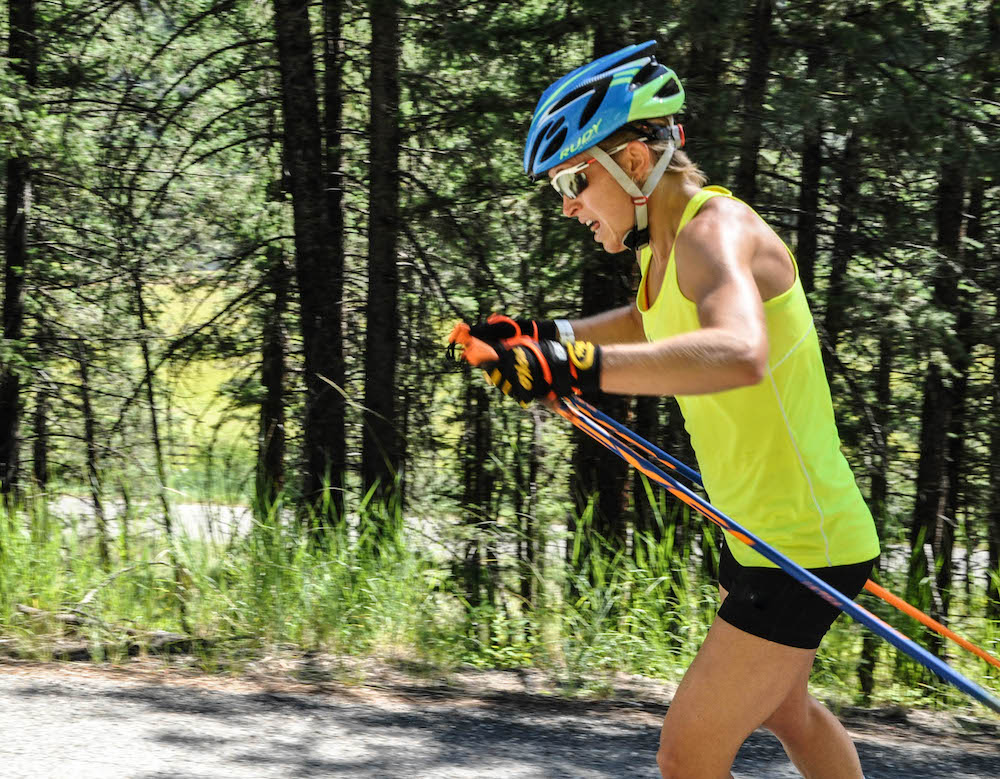
There is no faking a smile.
As a visual social-media feed, Instagram places a premium on how we’d like to be perceived by the viewing world. Instagram’s editing tools come with an assortment of beautifying filters.
But smiles? Fake smiles are filter-proof.
Although not a habitual Instagram poster, scroll through U.S. Ski Team (USST) athlete Liz Stephen’s account, @lizhillstephen — it’s hard not to notice her genuine grin and the smiles of those around her. Those smiles are for real.
There are other moments for Stephen when the disappointment is palpable. For instance, Stephen began the 30-kilometer freestyle at 2017 World Championships wearing bib 13. At 15 k, Stephen was less than a minute back from eventual winner, Norway’s Marit Bjørgen. By 25 k the gap to Bjørgen bumped to almost two minutes. Crossing the finish, Stephen was 3:09.4 minutes behind the Norwegian, good enough for 25th.
With her USST overcoat draped over her 5-foot-2 frame and it’s hood shrouding her face, it was clear there’d be no post-race comment. In her strongest technique, on a hill-climbing course in Lahti, Finland, the race and result were not what she’d hoped for.
Stephen is already a two-time Olympian (2010, 2014) and she’s gunning for a third in PyeongChang, South Korea. By the time those Games transpire, the up-tempo Park City, Utah, resident will be 31 years old.
Today at 30, Stephen still chases those smiles.
“Last year I just wanted to be a person,” Stephen said on the phone from Park City on Sept. 8. “Because that seemed to be what I needed to do in order to get happy. But it also kept me at altitude, at home in Park City. And it kind of kept me in the same stale spot for the whole summer.”
This dryland cycle, the Vermont native took note and modified her summer training plans — trying to maximize the benefits of training at altitude with low-elevation oxygen baths.
“This year I have been to Bend, I have been to Sweden, and I skipped New Zealand,” Stephen explained. “Kind of for those reasons, just because New Zealand is at altitude. I live at altitude, so I wanted all my camps to be as much as possible at sea level.”
Stephen spent time this summer training in relatively low Norway and Sweden. While in Sweden, accompanied by USST teammate Kikkan Randall, Stephen trained with the Swedish national women’s team. The Sweden camp proved a solid low-altitude respite.
“When I looked at the schedule, going to Sweden was a good fit,” Stephen said. “I’d always loved it there. I think I should probably have been a Swede. And I wanted to be inspired by them, which I was. I got my ass totally kicked in Sweden, in a good way, and in Norway. And, you know, I think it’s good to get your ass kicked sometimes, especially when it is mid-summer and you can come home and make some changes, which I have done. I came home [to Park City] and am psyched to be training, psyched to be a skier.”
When asked what those changes were, Stephen was clear and forthright in her response.
“We did kind of an interesting workout in Sweden that I actually just did this morning on the Erg,” Stephen said. “The idea is lactate production. That’s been something that I have struggled with over the last few years I think especially, and I think that this might be part physiological, just the type of athlete that I am, but also living at altitude has made me a little bit slower I guess in a lot of aspects. So in this workout, the idea is to produce as much lactate as possible. There is no pacing. You just go all out for 40 seconds on and 50 off. You do a bunch of rounds of this.
“I think for me, where I lose a lot in races is the ability to change speed,” she continued. “I can go forever, but races aren’t forever, they are only as long as they are. So you have to be able, especially with more mass-start races, you have to be able to stay with the pack and stay with the moves. And maybe sometimes make your own moves and that is where I think this workout could really benefit me.”

A few days after our interview, Stephen left Park City and flew back to her parents’ home in Vermont. There she planned to conduct an informal sea-level training camp with a schedule dense with hard interval training. Stephen returned to Park City at the end of September to take part in the USST training camp. And last Saturday, she ran the Red Bull 400 (a 400-meter near-vertical sprint to the top of a ski jump) in Park City for the third straight year, where she placed second behind Utah native Megan Foley.
In early September, Stephen said she felt good. But she’s quick to reflect that a professional endurance athlete’s life offers many opportunities to dwell.
“Definitely there are ups and downs, there always are,” she said. “I guess I should put it this way, as athletes we think in the moment all the time. We are supposed to be the best we can be every session. We are supposed to be doing the best we can. We are 24-hour athletes. Everything is so in the moment that it is really hard. We also take the negative parts of that too. You have a bad workout and all of a sudden, even if the day before was great, you live in the moment of the bad workout. So I think that’s always a challenge. I think for me, recognizing that is what is happening, and that the workout that you just completed that was really bad really doesn’t mean you are in terrible shape or that you are not a great athlete, it’s just where you’re at that day. I think there are always going to be ups and downs, and the trajectory of this year has been more positive than a couple years ago.”
Stephen said she remains undecided if she’ll continue her ski career after the 2017/2018 season. Her focus remains laser-like: be the best she can be mid-February in PyeongChang.
The 2018 Olympic cross-country race schedule offers several opportunities for Stephen. There’s the 10 k freestyle, the 15 k skiathlon and the 30 k classic mass start.
But five klicks remains the magic distance.
Stephen cannot deny that a potential skate leg start on the 4 x 5 k women’s relay team and helping her team win a medal remains a steadfast goal. With a plan in mind and quality training hours ticked off, does she internally think “5 k skate”?
“Yeah. Absolutely I do,” she said. “And I have said this to my psychologist a few times and others. That I, of course, for me, I am focused on that race in particular and I have been for years.”

With a strong USST women’s team and several domestic skiers striving to break through internationally, the USST coaches responsible for determining the relay squad may have a tough task culling the team down to four. A few years back, Stephen understood her inclusion on a 4 x 5 k relay team was almost automatic. Now her focus on that race is qualified.
“We have changed a little bit,” she said. “Specifically the psychological plan, just focused on that 5 k effort and that day and that race. But, but I also want it to be very clear that I want the team to medal. Not for myself. Even if I wasn’t on the team that day, that’s what I love about the relays — it’s not about one person. It’s about four. And whether I am one of those four people who have the best chance of winning that medal or skiing the fastest, I am not focused on that. I am focused on being the best I can be that day and hopefully that is good enough to be on that team.
“It is really kind of like a practice for your brain, I think, to decide what is most important to you and what you are going to go for,” she added. “And I think that it’s scary to put it out there. Yeah, I want to be on that team, but you know what? A lot of people that want to be on that team, and there are a lot of people that could be on that team. So yeah, I think it’s fun to have pressure like that and to have a goal, but it is certainly not something that I am banking on. Things can change in a heartbeat.”
Those types of changes are random — a stumble on a trail run, an errant pole plant while rollerskiing, a tumble on an icy World Cup course. This season Stephen decided to make a calculated change and switch to Madshus, a Norwegian-based company, for her skis.
“You know it’s a been a little bit tough this summer because I did have to leave Rossignol who I have been with for 15 years and they have been very good to me,” she said. “I am loyal. I am a loyal person. I felt like I needed to make a decision to change because I felt like after doing some testing, I felt like I needed to try a new ski.”
As the primary interface between skier and snow, nordic skiers can be obsessed with ski choice. On the World Cup, it’s not unheard of for skiers to travel with 40 pairs of skis. Just the sheer number of skis an athlete carries during the season begs the question of how Stephen will build a new ski quiver.
She won’t be starting from scratch.
“Ida Sargent on the U.S. Team has Madshus as well and we are similar sizes,” Stephen said. “We almost never do the same races. So the idea of having somebody to share skis with at times, both she taking mine and me taking hers if they are better on those days, takes the edge off of needing your own perfect fleet going into a very important year on very different skis than you are used to.”
To jumpstart her understanding of the new ski fleet, Stephen is planning a November pre-World Cup training trip with Sargent to La Forêt Montmorency in Quebec.
Heading into the season, much remains the same for Stephen. She’ll still charge headlong up the World Cup’s stout gradients. She’ll still smile for real. But along the journey, she’ll embrace the prospect of taking big performance risks where the outcome remains uncertain.
Jason Albert
Jason lives in Bend, Ore., and can often be seen chasing his two boys around town. He’s a self-proclaimed audio geek. That all started back in the early 1990s when he convinced a naive public radio editor he should report a story from Alaska’s, Ruth Gorge. Now, Jason’s common companion is his field-recording gear.



